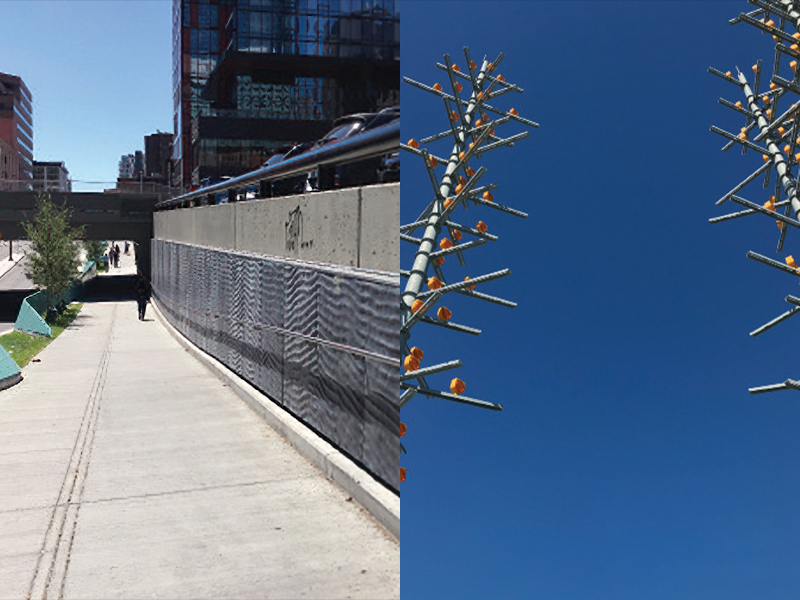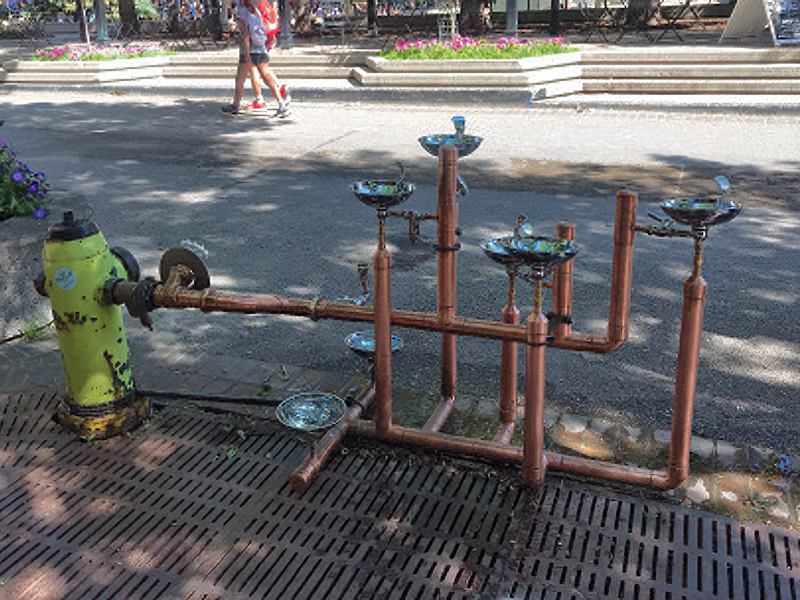Create Calgary: Telling Our Stories
Helen Hu, Calgary Arts Development’s public art administrator, takes a journey on the CTrain to rediscover the art that helps us navigate the city.
This article was originally published in Create Calgary, a new arts magazine launched by Calgary Arts Development in 2022 to celebrate the work of artists who call Mohkinsstsis/Calgary home. You can pick up a free copy at public libraries, community recreation centres and other places where you find your favourite magazines. You can also read the digital version online here.
One of my most prominent memories is seeing a rainbow tunnel and giant teeth sculptures while sitting in the backseat of my parents’ car. Two of Toronto’s most memorable public art pieces are situated east and west of the Don Valley Parkway. The Rainbow Tunnel, an iconic example of Toronto street art, has technicolour arches visible to northbound commuters for a vanishing moment before the Don Valley Parkway becomes ensnared with traffic. Before I knew what highways or street names were or even how to read a map, I always knew if I spotted the Rainbow Tunnel, we were heading north and away from home. If I saw Elevated Wetlands, the large grey sculptures I endearingly knew as the “giant teeth,” I knew we were heading home. Unbeknownst to me at the time, I was actively putting together a mental map to place myself within the bounds of the city I lived in. I carried this mental mapping process with me when I moved to Calgary as an adult, helping to acquaint myself with a new city.
For several years, and through many seasons, I commuted from Calgary’s McKnight-Westwinds CTrain station in the northeast to the downtown core to begin my day. It was a monotonous daily journey broken up by the welcome sights of visible public art along the way, indicating the time remaining on my trip and my place in the city. Under the surface, our ability to effortlessly navigate a familiar city is incredible when considering how little active thought is put into it.
In philosopher Fredric Jameson’s 1992 book, Postmodernism, or, the Cultural Logic of Late Capitalism, he introduces his theory of cognitive mapping. Cognitive mapping is an individual’s ability to conceive or imagine the place they occupy within the ideological space of the world. In other words, cognitive mapping is the ability to place oneself within the world. People tend to orient themselves within their environment to feel a sense of security. This need necessitates a search for landmarks, natural boundaries and roadways to cultivate markers in our minds and find comfort when navigating the physical space surrounding us. This underscores the importance of public spaces and our interaction with the built environment. What resonated with me the most was the idea that feeling alienated or disconnected in our cities resulted from our inability to cognitively map given the conditions we live in.
Jameson draws on urban planner Kevin A. Lynch’s writings from Lynch’s 1960 book, The Image of the City, to explain further. Jameson writes, “The alienated city is above all a space in which people are unable to map (in their minds) either their own positions or the urban totality in which they find themselves: grids such as those of Jersey City, in which none of the traditional markers (monuments, nodes, natural boundaries, built perspectives) obtain, are the most obvious examples.” In other words, a city empty of traditional markers will contribute to the alienation an individual might feel amidst the urban maze of concrete and steel.

Public art is a traditional landmark that can act like breadcrumbs for people to navigate through a city. Calgary’s public art collection is found throughout it, including along roadways, pedestrian pathways, parks, underpasses and public-transit junctions. Each piece offers a story of the unique community it lives in.
Like many cities in western North America, Calgary has the advantage of an above-ground light-rail transit system. For Calgary’s 116,700 average weekday CTrain commuters, art can serve as the landmark for destination and arrival. I decided to retrace my former CTrain commute and mark the public art touch points along the way.
The Commuter’s Eye
My journey began at the McKnight-Westwinds station. The platform shelter where I stood housed the work of Jim Hirschfield and Sonya Ishii, one of three works they completed at this station. Recollections is a series of colourful circles, each framing black and white photographs of individuals who have lived in the area through Alberta’s history, laminated into the glass panels of the shelter. These photographs were not only sourced from the Glenbow Museum’s archives, but donated by citizens of the surrounding community, as well. The colourful circles are an homage to the significance of circles within Blackfoot culture. Together, the photographs tell a story of a rural past and the grounded present. As I leaned in to look closer, I noticed other commuters glancing over and doing the same. Before I could move to another photograph, the train had arrived. This was a piece best taken in slowly, over multiple trips.
The train was fuller than I remembered from past trips from this starting point, perhaps even too crowded for comfort after the social conditioning of the pandemic. A convivial buzz of conversation continued past East Village, where many passengers dropped out of the train cars and onto the next legs of their destination.
I stepped off at City Hall and decided to detour through Olympic Plaza before I got back on the Red Line. At first, I couldn’t remember why I walked this way, but, when I came upon the Fire Hydrant Water Fountain — a matrix of copper tentacles serving water to the masses upon silver platters — I saw my reason; to make sure it was still there. Designed by WATERSHED+ lead artists Sans façon (Charles Blanc and Tristan Surtees), Fire Hydrant Water Fountain, adjacent to Olympic Plaza, is one of three art pieces the city unveils annually in the summer months. This one in particular is a group of bubbling fountains named Family. After admiring the piece, I continued walking — but not for long.
I stopped at a manhole cover on Stephen Avenue. I have seen these before during many lunchtime power-walks. It showed a sweet cherub with plump and wind-chapped cheeks, hair billowing feverishly about its face. Attributed to Calgary-based artist Garry Williams, the design recalls the winds and chinooks synonymous with our climate — Calgary’s bittersweet weather personified.
I ride the Red Line to the northern terminal stop. Tuscany Station is nestled in the median between the opposing lanes of Crowchild Trail N.W. It was my first time navigating this part of the Red Line and I disembarked the train and walked to the desolate parking lot. I needed fresh eyes for the journey home. As I pivoted to retrace my steps, I was greeted by Bill Pechet’s roger that. Inspired by the research of English physicist and philosopher Roger Penrose, roger that is a thoughtful interpretation of Penrose tiling; a form of irregular tiling in non-repeating patterns.
What seemed at first like a series of freestanding sculptures shadowed by the mid-morning sun, revealed themselves as a sequence of safety-yellow circles perched on galvanized steel rods like a flock of birds. Noticing the sharp colour contrast with the cloudless sky, I stopped to take a picture. I wanted to remember this contrast of yellow against a sky saturated with intense blue.
But, I was missing something. Continuing through the CTrain entrance, I descended to the platform where a city-bound train awaited. I found a seat that looked to the other side of Crowchild Trail, where the counterpart of roger that was located. Eureka! From where I sat, I had a new vantage point and could see the constellation of yellow circles coming together as a perfectly uniform concentric circle. Here, I found the play of the piece’s name nestled within, and roger that was not only a reference to Roger Penrose, but also to the moment when it all comes together, connecting across the highway as two distant radio operators making contact. The train began to move, and the circles again dispersed into a constellation. What had changed was my perspective.
I was less enthusiastic about the return stretch home. At this point, I was tired and likely dehydrated. But, as I came upon the main thoroughfare to take me home, the final node of my journey, it occurred to me to check in with one last installation, this one in my own backyard (and perhaps yours, too). The 5th Street underpass with Jill Anholt’s Below/Before/ Between is an integrated artwork that reminds us of Calgary’s connection to the Bow and Elbow rivers, but is also a nod to the Prairie landscape with its planted native grasses. I check to see how the grass is doing and it’s taking root nicely.
I didn’t set off to find my everyday commute or yours. I set out to find the artful markers of the city, those connective tissues between civic space and civic life. Public art cultivates the landmarks we seek in our built environments, and the city’s collection serves as an ensemble of connection points. To connect with any of the pieces is to connect with ourselves and our community. And, although the nodes of public art may form the outline of our collective maps, how we fill in the rest is up to us as we, as a city, determine our common future.

